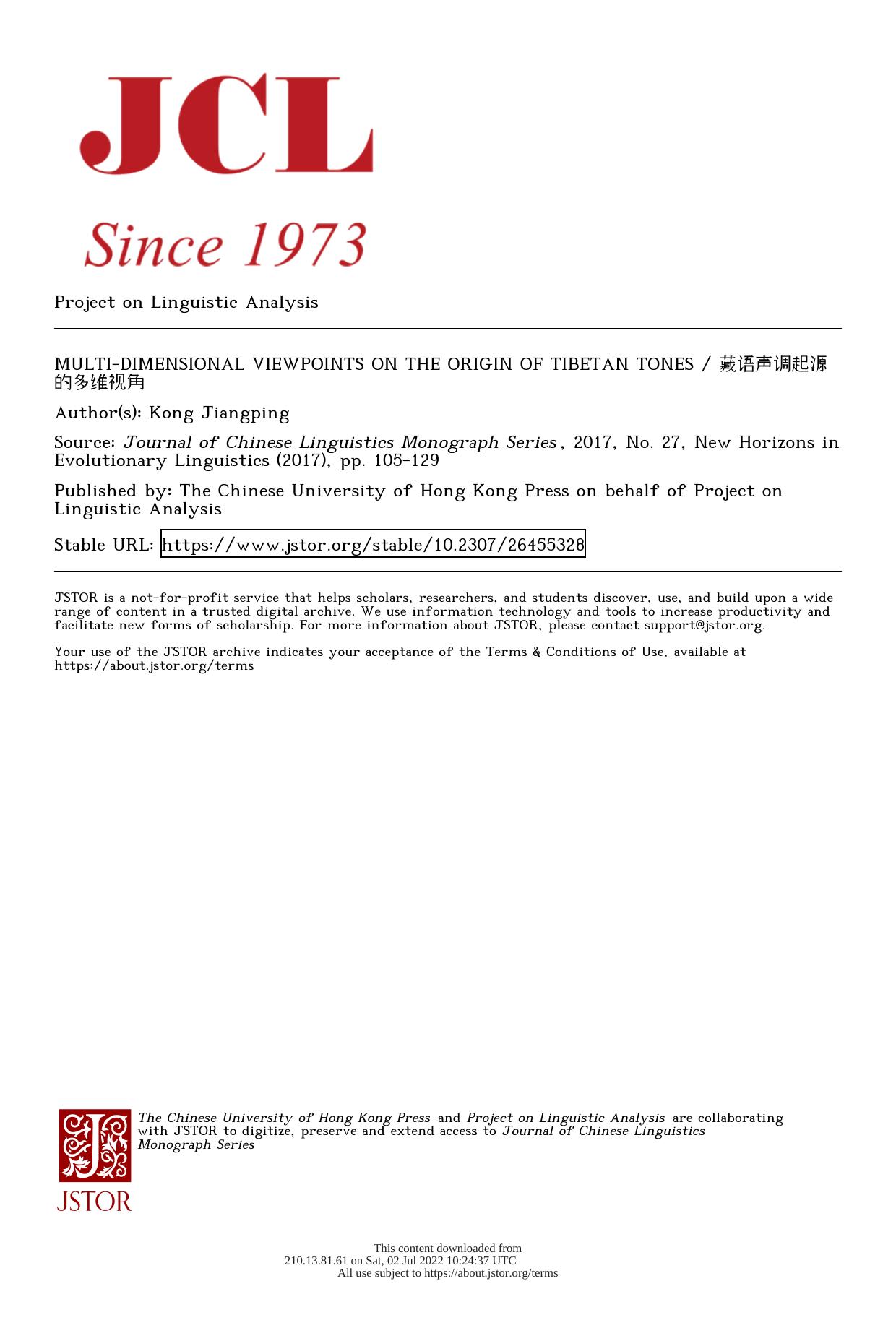Download MULTI-DIMENSIONAL VIEWPOINTS ON THE ORIGIN OF TIBETAN TONES / 藏语声调起源的多维视角 PDF Free - Full Version
Download MULTI-DIMENSIONAL VIEWPOINTS ON THE ORIGIN OF TIBETAN TONES / 藏语声调起源的多维视角 by 孔江平 (Kong Jiangping) in PDF format completely FREE. No registration required, no payment needed. Get instant access to this valuable resource on PDFdrive.to!
About MULTI-DIMENSIONAL VIEWPOINTS ON THE ORIGIN OF TIBETAN TONES / 藏语声调起源的多维视角
The production and origin of Tibetan tones were studied from multiple viewpoints. The following results and conclusion were obtained: 1) homophone is the internal impetus of the production and the origin of Tibetan tones, but the origin of Tibetan tones was restricted by the phoneme structure; 2) the distributions of homophone in all the Tibetan dialects are close to an exponential curve, which is the basic nature of Tibetan; 3) from the viewpoint of phoneme evolution, the phoneme load could transfer among the initials, finals and tones. The increase of initial loads led to the pitch patterns being transferred to the tone patterns; 4) this study proposed the concept of 'quasi-phoneme'; 5) from the viewpoint of structure diffusion in the lexicon, the structure diffusion was caused by the decrease of initials and finals: 6) in the production and origin of Tibetan tones, the formation of tones was restricted physiologically and psychologically by phonation and perception. The devocalization of the initial is the basis for the origin of tones.<p>本文从不同的视角对藏语声调产生和起源进行了研究,研究主要得到了以下结论:1)同音词的增加是导致藏语产生声调的主要内在动力。从结构的演化来看,声调的产生又受到藏语音位系统结构的制约;2)同音词的分布在藏语各方言中都是遵循指数曲线,这是藏语音位的基本内在性质;3)从音位负担的演化来看,在藏语信息量为常数的情况下,声、韵、调三者的音位负担可以相互转换,藏语声母负担的增加直接导致了声调的产生,因此,藏语的音调转换为声调;4)提出了“准音位”的感念;5)从语音结构在词汇中的扩散和语音演化看,藏语声、韵母减少形成了藏语语音结构在词汇中的扩散;6)声调产生过程中,语音的演化主要受制于发音生理机制和感知机制,声母清化是声调产生的感知基础。<br></p>
Detailed Information
| Author: | 孔江平 (Kong Jiangping) |
|---|---|
| Publication Year: | 2017 |
| Pages: | 26 |
| Language: | other |
| File Size: | 23.5277 |
| Format: | |
| Price: | FREE |
Safe & Secure Download - No registration required
Why Choose PDFdrive for Your Free MULTI-DIMENSIONAL VIEWPOINTS ON THE ORIGIN OF TIBETAN TONES / 藏语声调起源的多维视角 Download?
- 100% Free: No hidden fees or subscriptions required for one book every day.
- No Registration: Immediate access is available without creating accounts for one book every day.
- Safe and Secure: Clean downloads without malware or viruses
- Multiple Formats: PDF, MOBI, Mpub,... optimized for all devices
- Educational Resource: Supporting knowledge sharing and learning
Frequently Asked Questions
Is it really free to download MULTI-DIMENSIONAL VIEWPOINTS ON THE ORIGIN OF TIBETAN TONES / 藏语声调起源的多维视角 PDF?
Yes, on https://PDFdrive.to you can download MULTI-DIMENSIONAL VIEWPOINTS ON THE ORIGIN OF TIBETAN TONES / 藏语声调起源的多维视角 by 孔江平 (Kong Jiangping) completely free. We don't require any payment, subscription, or registration to access this PDF file. For 3 books every day.
How can I read MULTI-DIMENSIONAL VIEWPOINTS ON THE ORIGIN OF TIBETAN TONES / 藏语声调起源的多维视角 on my mobile device?
After downloading MULTI-DIMENSIONAL VIEWPOINTS ON THE ORIGIN OF TIBETAN TONES / 藏语声调起源的多维视角 PDF, you can open it with any PDF reader app on your phone or tablet. We recommend using Adobe Acrobat Reader, Apple Books, or Google Play Books for the best reading experience.
Is this the full version of MULTI-DIMENSIONAL VIEWPOINTS ON THE ORIGIN OF TIBETAN TONES / 藏语声调起源的多维视角?
Yes, this is the complete PDF version of MULTI-DIMENSIONAL VIEWPOINTS ON THE ORIGIN OF TIBETAN TONES / 藏语声调起源的多维视角 by 孔江平 (Kong Jiangping). You will be able to read the entire content as in the printed version without missing any pages.
Is it legal to download MULTI-DIMENSIONAL VIEWPOINTS ON THE ORIGIN OF TIBETAN TONES / 藏语声调起源的多维视角 PDF for free?
https://PDFdrive.to provides links to free educational resources available online. We do not store any files on our servers. Please be aware of copyright laws in your country before downloading.
The materials shared are intended for research, educational, and personal use in accordance with fair use principles.

